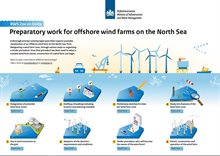Preparatory work for offshore wind farms

Hotspots
1. Designation of potential wind farm zones
The designation of wind farm zones is a spatial assessment aimed at finding locations for wind farms on the intensively used North Sea. Conditions must be favourable in these locations. At the same time offshore wind energy must, where possible, dovetail with other activities such as shipping and fisheries, ecology, protected nature areas and with interested parties in the immediate environment. The Dutch government defines new wind farm zones in the North Sea Programme. This forms part of the National Water Programme 2022-2027. New offshore wind farms on the North Sea may be built in such designated areas only.
2. Drafting a Roadmap including location and planning schedule
The Ministry of Economic Affairs and Climate Policy drafts an ‘Offshore Wind Energy Roadmap’; a sort of programme booklet that shows which energy zone (or part thereof) is being developed into a wind farm, and what the planning schedule for that is. The Roadmap 2030 gives an outline sketch of the developments for the period 2024-2030, which envisages generating around an extra 7 gigawatts of offshore wind energy. By way of comparison: the operational wind farms from before 2022 in the Dutch section of the North Sea, together, supply around 2.5 gigawatts. 1 gigawatt can provide electricity for around 1 million households.
3. Preliminary sketches for sites per wind farm zone
It is often the case that the designated wind farm zones are not exclusively used for wind energy. To use the space as efficiently as possible the first step is to make preliminary sketches showing one or more sites within each designated wind farm zone. In advance of the site decisions these preliminary sketches may yet change, depending on possible new results from studies and other insights in the area. When mapping out the individual sites the Environmental Impact Report (EIR) for the zone is also taken into account.
4. Study into features of the wind farm zone
In this preliminary stage, the sites in the wind farm zonemust be mapped out. This is a process which requires location studies: extensive studies into the features and existing use of a wind farm zone. These location studies are put out to tender among market parties by the government. The information is important for the subsequent wind farm developers, aspects such as wind speed, water depth, wave height, condition of the seabed, archaeology and the presence of shipwrecks and unexploded ordnance.
5. Sea to land connection to the grid
In order to be able to bring the produced wind energy onto the land, an electricity cable must be laid to a high voltage station on land. The process of determining the course of this is subject to a careful procedure in which all various interests are considered, both at sea and on land. For instance,
the course is, in part, dependent on the results of the prior environmental impact report. The government has designated TenneT as network operator for the offshore grid. For more information, see Offshore Grid.
6. Adoption of site decision: requirements and conditions
A site decision determines the conditions under which a wind farm within a designed site may be built and operated. This concerns regulations such as those relating to the height of a turbine, the maximum rotor surface area or the minimum capacity. But the site decision also covers the noise standard
for pile driving under water during the construction of a wind turbine and the stipulation that no nitrogen deposition may be caused in Natura 2000 areas (which are sensitive to this) during the maintenance phase of wind farms.
7. Tender procedure: who will become the owner of the wind farm?
Once the site decision has been made definitive, the Netherlands Enterprise Agency, on behalf of the Ministry of Economic Affairs and Climate Policy, organises a tender procedure for the allocation of sites. Commercial parties with an interest in a particular site may submit proposals. From all the submissions, one party will ultimately emerge as the winner. This party will be awarded a permit for the construction and operation of the wind farm on the site in question and, accordingly, will become the owner of the wind farm.
8. Permit, construction and operation of the wind farm
As soon as the winner of the tender is known, the new owner will receive the permit allowing it to make a start on preparatory work for the construction of the wind farm. The process from the point at which the permit is issued until a wind farm is fully operational takes about four years. Together with the National Mines Inspectorate, Rijkswaterstaat is responsible for oversight and enforcement during the preparatory work, construction and operation of the wind farm.